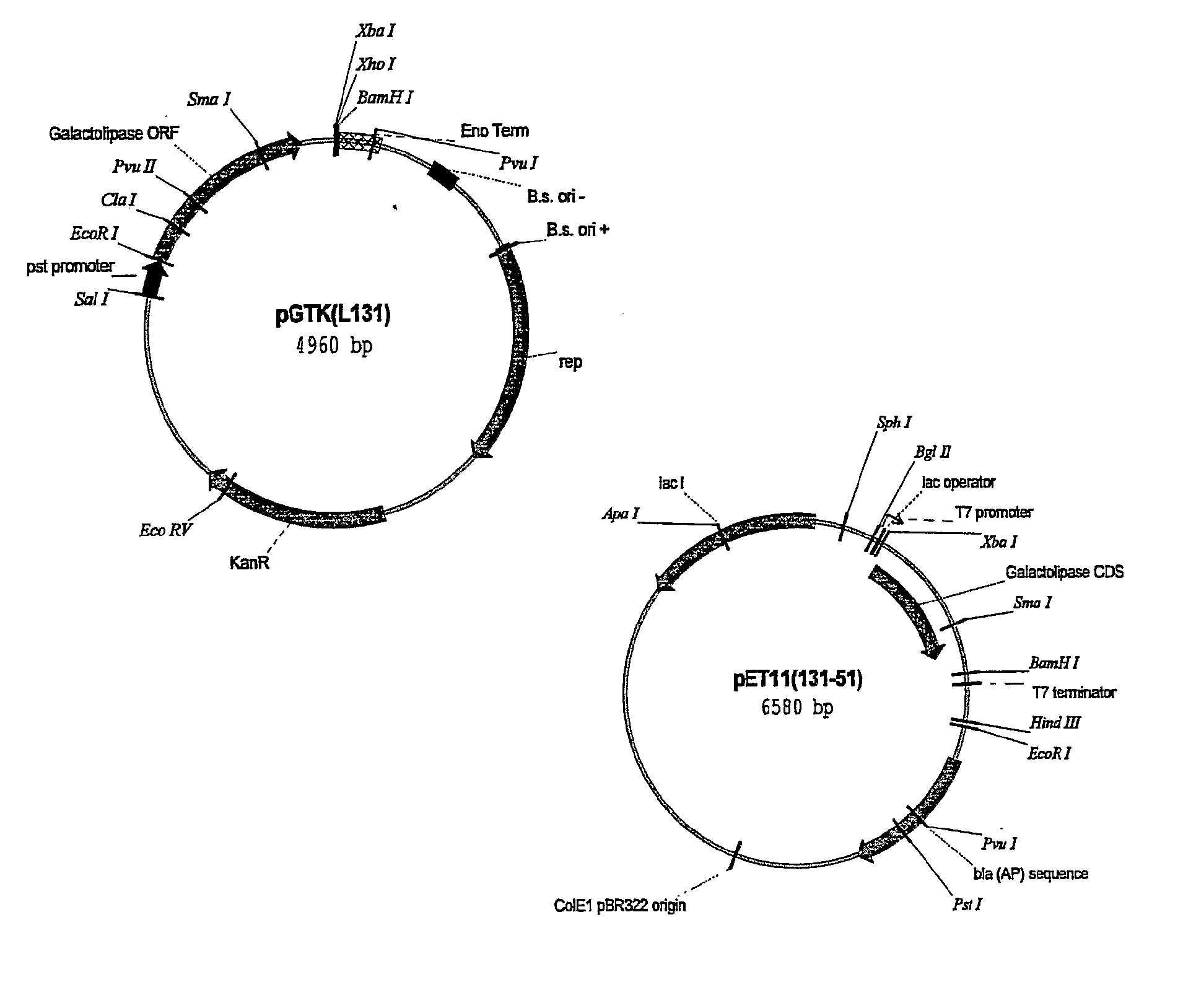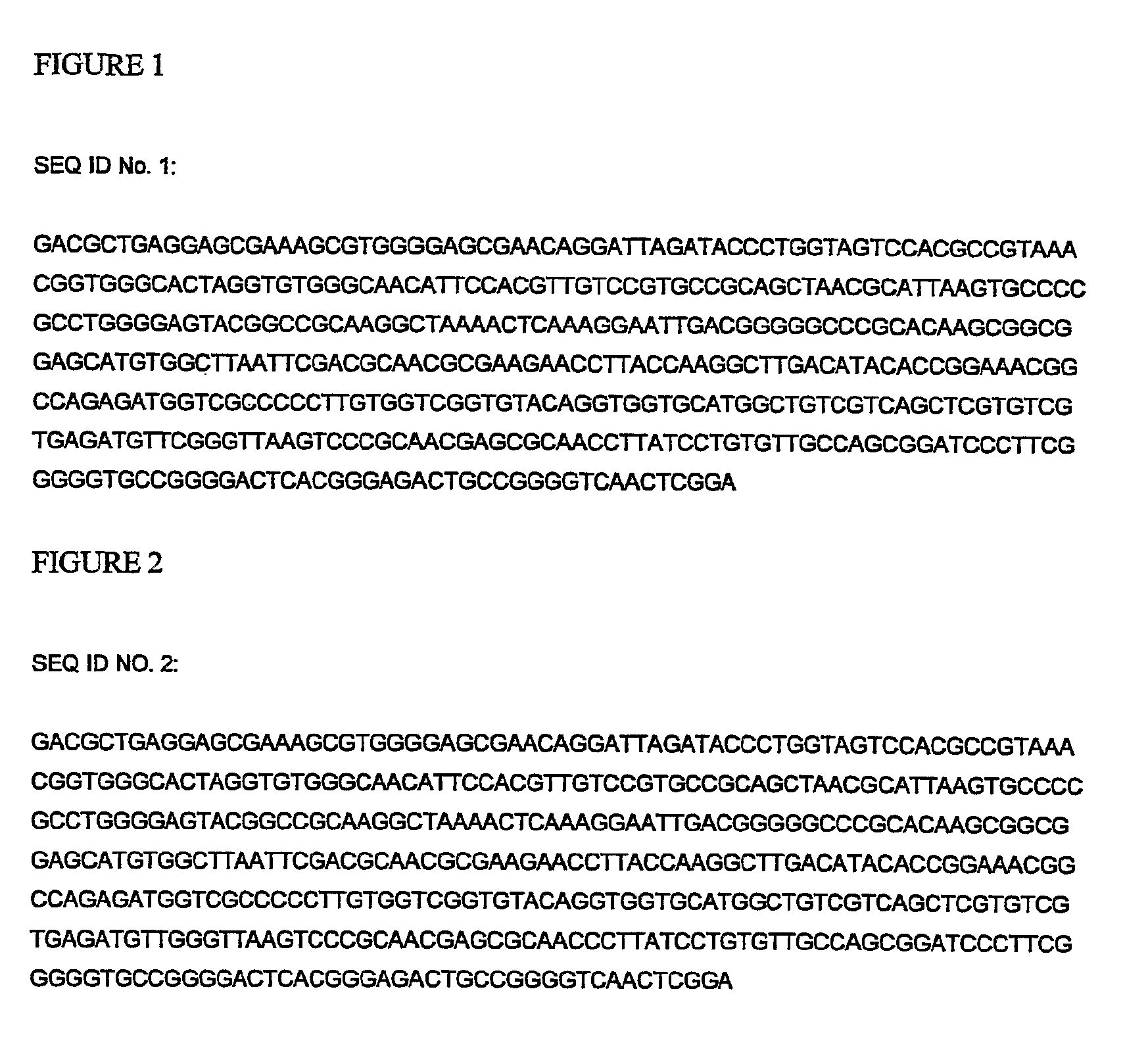Lipolytic enzyme: uses thereof in the food industry
a technology of lipolytic enzyme and lipolytic enzyme, which is applied in the direction of enzymes, baking, sugar derivatives, etc., can solve the problems of unnecessarily high free fatty acid, and document does not teach lipolytic enzymes from i>streptomyces
- Summary
- Abstract
- Description
- Claims
- Application Information
AI Technical Summary
Benefits of technology
Problems solved by technology
Method used
Image
Examples
example 1
Identification of a Galactolipase Producing Bacterial Strain
[0392] Two microbial strains with a similar phenotype coded L130 and L131 were isolated from soil collected in Southern Finland. The 16S RNA genes of these two strains were amplified by standard PCR using oligonucleotide primers 536f (CAGCMGCCGCGGTAATWC) and 1392r-primer (ACGGGCGGTGTGTRC). The resulting PCR fragments were partially sequenced. SEQ ID No.s 1 and 2 are non-enzyme encoding polynucleotides. These sequences are ribosomal 16S RNA genes widely used for taxonomic comparisons. SEQ ID No. 1 and SEQ ID No. 2 were found to have a high similarity. The sequences were then compared to the 16S RNA gene sequences in GenBank. For both isolates the highest homology (97%) was observed with the sequence of a 16S RNA gene from Streptomyces thermosacchari. Thus, the strains were named Streptomyces sp. L130 and Streptomyces sp. L131.
example 2
Preparation of Lipolytic Enzyme (Galactolipase) Samples from Strains Streptomyces sp. L130 and L131
[0393] 0.5 l of LB medium was inoculated with Streptomyces L130 and cultivated on a rotary shaker at 200 rpm and 30° C. for 2 days. This culture was used as inoculum for a 10 l fermentor containing the same medium. The cultivation was continued for 3 days at 30° C., 600 rpm stirring rate and 0.5 v / v aeration. The fermentation broth was cleared by centrifugation (15 min at 5000 rpm) and Triton X-100 was added to final concentration of 0.1%. The solution was concentrated using Vivaflow 200 ultrafiltration cell (Vivascience AG, Hannover, Germany) to 300 ml. The concentrate was dialysed against 10 l of 20 mM Tris HCl buffer, pH 7 containing 2 mM CaCl2 and 2 mM MgCl2 followed by dialysis against 0.5 l ml of 85% glycerol. The resulting preparations contained 90 U of galactolipase activity assay as defined above (GLU-7).
[0394] The strain Streptomyces L131 was cultivated under the same condi...
example 3
Baking Experiments
[0395] The galactolipases from bacterial isolates L130 and L131 indicated a high activity on polar lipid substrates, galactolipids (DGDG) and phospholipids, (galactolipase and phospholipase activity), equivalent to that of a Fusarium oxysporum lipase (Lipopan F™ Novozymes A / S Denmark): however the galactolipase from bacterial isolates L130 and L131 (i.e. the lipolytic enzyme according to the present invention) were found to have no significant activity of triglycerides. This contrasts sharply with the activity Fusarium oxysporum lipase—LipopanF™.
[0396] The lipolytic enzymes from bacterial isolates L130 and L131 were prepared as described in Example 2 and were analysed for characterisation of their activity on glycolipids, phospholipids and triglycerides, both in standard assay conditions and within a dough.
[0397] Small scale baking experiments and a model dough system. Both enzymes are very active on galactolipids in flour.
Materials and Methods.
[0398] Three s...
PUM
| Property | Measurement | Unit |
|---|---|---|
| pH | aaaaa | aaaaa |
| pH | aaaaa | aaaaa |
| concentration | aaaaa | aaaaa |
Abstract
Description
Claims
Application Information
 Login to View More
Login to View More - R&D
- Intellectual Property
- Life Sciences
- Materials
- Tech Scout
- Unparalleled Data Quality
- Higher Quality Content
- 60% Fewer Hallucinations
Browse by: Latest US Patents, China's latest patents, Technical Efficacy Thesaurus, Application Domain, Technology Topic, Popular Technical Reports.
© 2025 PatSnap. All rights reserved.Legal|Privacy policy|Modern Slavery Act Transparency Statement|Sitemap|About US| Contact US: help@patsnap.com



